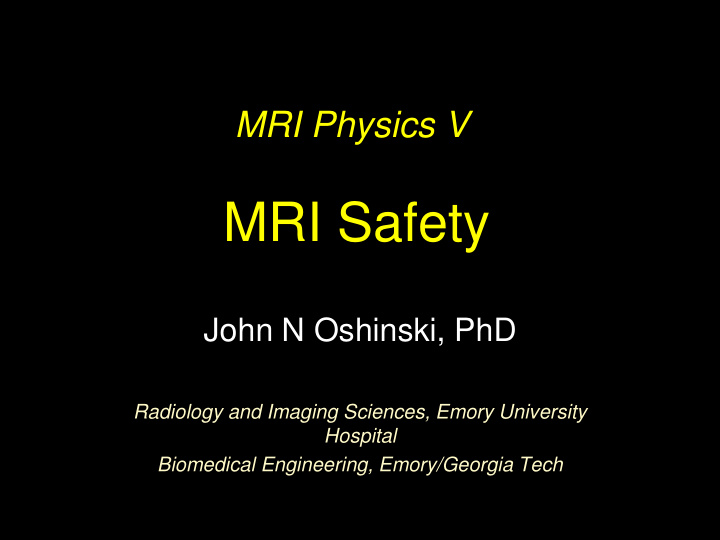



MRI Physics V MRI Safety John N Oshinski, PhD Radiology and Imaging Sciences, Emory University Hospital Biomedical Engineering, Emory/Georgia Tech
MRI Safety 1. Static Main Magnetic Field 2. Radio Frequency (RF) pulse 3. Gradient Field 4. Devices/Implants 5. Will not talk about contrast agents MR Physics 5
What causes the most safety issues in MRI?
Shield coils : reduces fringe field effects Shim coils : improves homogeneity of a region Gradient Coils : added changing electromagnetic field for imaging Surface RF coils : Use to receive signal Body RF coil : Use to transmit/receive field Main Field Coil : Primary coil that produces Main field (static field – does not change)
MRI Safety 1. Static Main Magnetic Field 2. Radio Frequency (RF) pulse 3. Gradient Field 4. Devices/Implants 5. Will not talk about contrast agents MR Physics 5
Main Magnet Safety Concerns • Missile Effect – Any ferromagnetic object can be accelerated into the bore – Force dependent on • Size/weight • Ferromagnetic content • Magnetic field spatial gradient – An object’s torque and path are unpredictable • Device Effects (5 gauss line) • Patient Effects (at high fields)
• https://www.youtube.com/watch?v=lEJ2 notNLo0 • https://www.youtube.com/watch?v=vIQa Gt_fkkw MR Physics 1 <#>
July 2001
MR Physics 1 <#>
Static Magnetic Field Draw on board
Patient removal when a metallic object is present • DO NOT attempt to move the object or ANY PART of the scanner (including the table) • The object may change its magnetic polarity if dislodged and re-align with the field and become a projectile • FIRST priority is to remove the patient • Bring in MR compatible stretcher • Transfer patient to the stretcher without dislodging the object or disturbing the parts of the scanner
“Shut off” Buttons What do these buttons do? How are they different?
Site Modifications for Static Field Safety
Static Magnetic Field Must Have Controlled Supervised Access Zone I: Freely Accessible to General Public Zone II: Interface Between Uncontrolled and Strictly Controlled Zone - Patients must be escorted. Zone III: Control room and space with access to scanner door - Strictly Controlled by MR Personnel With Restricted Access Zone IV: MR Scanner Magnet Room - Clearly marked with red light and lighted sign.
Static Magnetic Field Must Have Controlled Supervised Access
Metal Detectors
Marking of Magnetic Field Lines
Screening Form
What do you do if something is positive on screening form? • If a device: – What does manufacturer say? MRIsafety.com website – Does patient have info or card? – If Nitinol or Titanium, its generally OK immediately after placement – If it has electronics – generally stay away from scanning • Special cases – Bullet or shrapnel fragment – Metal in eye – Have they sought medical attention? – Aneurysm clips – Pacemaker or pacemaker leads
Designations of Devices and Equipment MR Safe MR Conditional MR Unsafe MR compatible*
What is the most important factor for Static Field MRI safety? • Educate and Empower the MRI Techs • They are in charge of access to control room and scanner
MRI Safety 1. Static Main Magnetic Field 2. Radio Frequency (RF) pulse 3. Gradient Field 4. Devices/Implants 5. Will not talk about contrast agents MR Physics 5
RF Pulse Safety • Heating and Burns • General Rules: – Beware conductors near the surface – Beware of loops or long lengths of wire MR Physics 1 <#>
Specific Absorption Rate (SAR) • Measure of the absorbed RF energy that can cause heating • US FDA limits this to 4.0 W/kg in the body • Difficult to measure, so its modelled • Formula for a sphere says SAR = s r 2 B 0 2 a 2 D • This is calculated by manufacturer and they will tell you when you are in danger of exceeding it.
RF Burns RF Burns from poorly insulated coil – Inspect coils perioically
RF and Tattoos • May cause artifacts or short-term skin reactions • Frequency and severity of reactions is low • Should not prevent a patient from undergoing an MRI exam. • Beware of iron-oxide based pigments.
Non-obvious RF issues Everyone changes into patient gown
MRI Safety 1. Static Main Magnetic Field 2. Radio Frequency (RF) pulse 3. Gradient Field 4. Devices/Implants 5. Will not talk about contrast agents MR Physics 5
Gradient System Safety Concerns • Acoustic Noise – Due to gradient force/pressure vibrations within the coil housing • Nerve Stimulation – Fluctuating current may cause nerve stimulation
Acoustic Noise • Noise level must be below 99 dB with protection in place. • Hence everyone get hearing protection. – Ear pugs – Earphones
Summary • MR Safety is a group effort - best to have a committee (Radiologists Physicists, hospital administration, nursing, building services) • Pay attention to the screening form and talk to patients. • Biggest issue is burns. Beware of loops and conductors near the surface • Worse scenario is missile with patient inside • Let the MR Technologists be in charge.
Recommend
More recommend